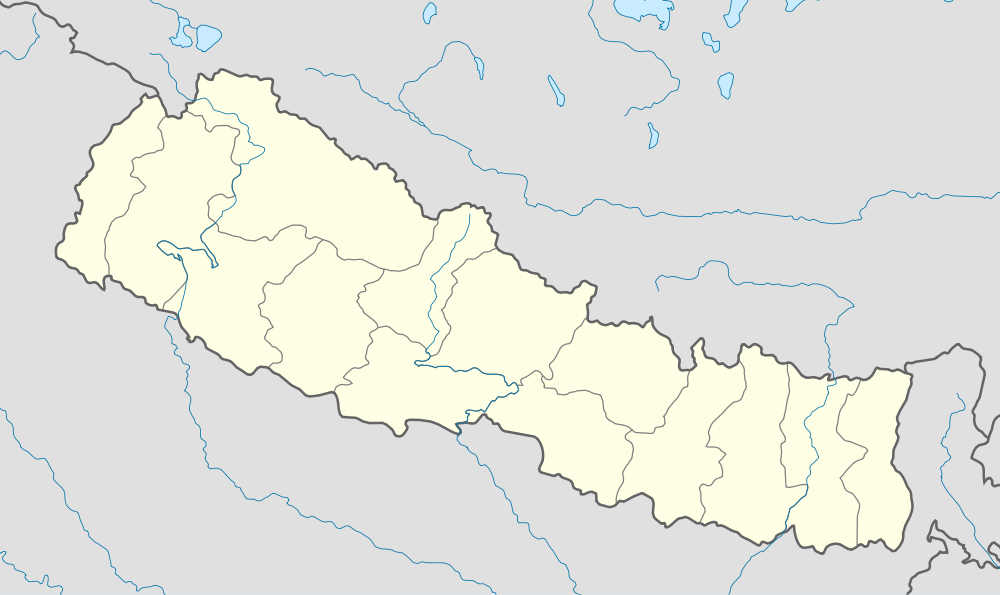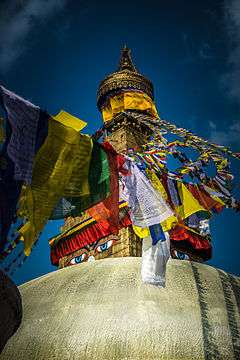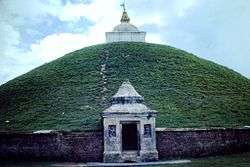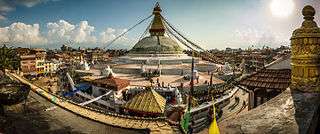Boudhanath
| Boudhanath बौद्धनाथ | |
|---|---|
|
Boudhanath Panorama | |
 Shown within Nepal | |
| Basic information | |
| Location | Kathmandu, Nepal |
| Geographic coordinates | 27°43′17″N 85°21′43″E / 27.72139°N 85.36194°ECoordinates: 27°43′17″N 85°21′43″E / 27.72139°N 85.36194°E |
| Affiliation | Buddhism |
| Architectural description | |
| Architectural type | Stupa |
| Specifications | |
| Height (max) | 36 metres (118 ft)[1] |
| Official name: Kathmandu Valley | |
| Type | Cultural |
| Criteria | iii, iv, vi |
| Designated | 1979 (3rd session) |
| Reference no. | 121 |
| State Party |
|


Boudhanath (Devanagari, Nepali: बौद्धनाथ) (also called Boudha, Bouddhanath or Baudhanath or the Khāsa Caitya) is a stupa in Kathmandu, Nepal. It is known as Khāsti in Nepal Bhasa, Jyarung Khashor in Tibetan language (Tibetan: བྱ་རུང་ཁ་ཤོར། Wylie: bya rung kha shor) or as Bauddha by speakers of Nepali.[2] Located about 11 km (6.8 mi) from the center and northeastern outskirts of Kathmandu, the stupa's massive mandala makes it one of the largest spherical stupas in Nepal.[3]
The Buddhist stupa of Boudhanath dominates the skyline. The ancient Stupa is one of the largest in the world. The influx of large populations of refugees from Tibet has seen the construction of over 50 Tibetan Gompas (Monasteries) around Boudhanath. As of 1979, Boudhanath is a UNESCO World Heritage Site. Along with Swayambhunath, it is one of the most popular tourist sites in the Kathmandu area.
The Stupa is on the ancient trade route from Tibet which enters the Kathmandu Valley by the village of Sankhu in the northeast corner, passes by Boudnath Stupa to the ancient and smaller stupa of Cā-bahī (often called 'Little Boudnath'). It then turns directly south, heading over the Bagmati river to Patan - thus bypassing the main city of Kathmandu (which was a later foundation).[2] Tibetan merchants have rested and offered prayers here for many centuries. When refugees entered Nepal from Tibet in the 1950s, many decided to live around Boudhanath. The Stupa is said to entomb the remains of Kassapa Buddha.
Mythology
Padmasambhava Buddhism

This Bauddha stupa was built just after the demise of Lord Buddha and is the largest single Chhorten in the world. Many kilograms of gold were used in the decoration of the holy building. The legend of its building begins with one person:
An Apsara in a previous life, Jyajima (Tibetan: བྱ་རྫི་མ། Wylie: bya rdzi ma) was born into a very ordinary family of the earth after the reduction of her religious merit from the heaven. She had four husbands, and gave birth to four sons from each of her husbands. Tajibu (Tibetan: རྟ་རྫིའི་བུ། Wylie: rta rdzi'i bu) was born of a horse trader, Phagjibu (Tibetan: ཕག་རྫིའི་བུ། Wylie: phag rdzi'i bu) from a pig trader, khyijibu (Tibetan: ཁྱི་རྫིའི་བུ། Wylie: khyi rdzi'i bu) from dog trader and Jyajibu (Tibetan: བྱ་རྫིའི་བུ། Wylie: bya rdzi'i bu) from poultry business man. They had a most religious attitude, and decided to construct the largest chhorten (stupa). The land necessary for the stupa was made available by Majyajima (Tibetan: མ་བྱ་རྫི་མ། Wylie: ma bya rdzi ma), and construction was started soon after. The construction materials of soil, bricks and stones were carried on elephants, horses, donkeys etc. Majyajima died four years later, after completion of four stories of the structure, and after three more years of ceaseless efforts, the sons completed The Baudha stupa. It took almost seven years in total to complete the construction of the stupa.
It is believed that thousands of Buddhas and heavenly Deities incarnated as Lamas in the Baudha stupa It is said that because of Rabne, the rays of Bodhisattvas entered in the song from heaven and the holy sound of was heard in the sky. Due to being empowered by the Bodhisattvas this stupa is viewed with a great reverence as are Sangye Tong Duspai Chorten (Tibetan: སངས་རྒྱས་སྟོང་འདུས་པའི་མཆོད་རྟེན། Wylie: sangs rgyas stong 'dus pa'i mchod rten) etc.
After the completion of the construction of Boudha stupa, Tajibu prayed very devoutly to become the king of the northern region to disseminate the religion, so he was the Dharma King Trisong Detsen of Tibet in his next life. Phagjibu wished to be a scholar to disseminate the religion, and he became Bodhisattva Śāntarakṣita, an enlightened teacher in Tibet in the next birth. Khyijibu was incarnated as the enlightened Guru Rinpoche Padmasambhava on Ashada Dashain (on the tenth day of lunar calendar of first half of Ashada) in Oddiyana, Oḍḍiyāna (Skt. Oḍḍiyāna; Tibetan: ཨུ་རྒྱན།, Wylie: u rgyan, Oriya: ଓଡ଼ିଆଣ), in the southwest area, at Dhanakosha lake. He suppressed the Demons who were barriers to the religion and conserved and protected the religion from the Demonic attacks. Jyajibu prayed to be a minister for the protection of religion in the north and as an answer to his prayer he was born at Tibet and became the minister Bhami Thri Zher (Tibetan: སྦ་མི་ཁྲི་བཞེར། Wylie: sba mi khri bzher).
All of these person prayed for themselves but they did not pray for the animals, who transported bricks, soil, and stone. So these animals became angry and the elephant prayed to be the Demon in the next life to eliminate the religion. So he became the King Langdarma of Tibet in the next life, where Tajibu had disseminated the holiest religion. In the same way, the Donkey prayed to become a minister in the next life to destroy the religion and he too became a minister Dudlon Mazhang Drompakye (Tibetan: བདུད་བློན་མ་ཞང་གྲོམ་པ་སྐྱེས། Wylie: bdud blon ma zhang grom pa skyes) in Tibet.
A crow listened the prayers of these animals who prayed for the destruction of the holiest religion, and he (the crow) prayed to the Bauddha Stupa to be a minister to protect and preserve the holy religion by killing the demonic king Langdarma (Tibetan: རྒྱལ་པོ་གླང་དར་མ། Wylie: rgyal po glang dar ma) in the next life. He was born as Lha Lung Pal Gyi Dorje (Tibetan: ལྷ་ལུང་དཔལ་གྱི་རྡོ་རྗེ། Wylie: lha lung dpal gyi rdo rje) in the next life, and assassinated King Lang Darma with a bow and arrow.
The cowherds and shepherds, who prayed for the protection of religion and suppression of demons (who were attempting to eliminate the holy religion), were born as Cholon Gos Padma Gung Tsan (Tibetan: ཆོས་བློན་འགོས་པདྨ་གུང་བཙན། Wylie: chos blon 'gos padma gung tsan) in Tibet to conserve the religion. In the same way, Chodpurchan and Sarse, two Brahmins who prayed to the stupa to be born in the holy country and to write the holy literature were reborn in the next life as Kawa Paltsek (Tibetan: སྐ་བ་དཔལ་བརྩེགས། Wylie: ska ba dpal brtsegs) and Chogro Lhui Gyaltshan (Tibetan: ཅོག་རོ་ཀླུའི་རྒྱལ་མཚན། Wylie: cog ro klu'i rgyaltshan); these two translated thousands of holy teachings of Lord Buddha into Bhoti (Tibetan) Language.
In addition to this, two crown princes of Nepal prayed to be helpers in dissesminating the religion, and they became Denma Tsemang (Tibetan: ལྡན་མ་རྩེ་མང་། Wylie:ldan ma rtse mang) and Legzyin Nyima (Tibetan: ལེགས་བྱིན་ཉི་མ། Wylie: legs byin nyi ma) in their next lives and wrote many holy books. Along with this, the religious king of Tibet, Dechen Devachan asked the greatest teacher Rinpoche: "what could be the factor and cultural background of our previous life that made us deeply devoted in religion and active in disseminating religious matters"? He was answered and was reverently referred by the Guru as 'Jyarung Khashor.
Myths of The Holy Stupa
Once in ancient Nepal, there lived a very grumpy, rude and irreligious man. He was detested by everyone and never did anything pious in his life. He owned a shop in the city complex, but hardly anyone came to his shop because he spoke ill of everyone who came there. When he died, he fell straight to hell. Just before he was to be sentenced for his sins, The Buddha appeared and nullified his sentence. When the demons asked The Holy One why he did this, The Buddha answered, "Yes, this man has committed many sins in his life, but once he circled around Boudhanath while chasing a dog, he had gained a little merit; thus, the buddhas shall grant him one chance to atone." After this incident, it is believed that if a person has committed great sins, they can circle around the stupa--if only one time--and be granted one chance to atone for their sins.
Legend of the construction of the stupa according to Tibetan Buddhist mythology
- "The village that surrounds the great Kāṣyapa stupa is generally known by the name of Bauḍḍha. ...which in Tibetan is called Yambu Chorten Chenpo (Tibetan: ཡམ་བུའི་མཆོད་རྟེན་ཆེན་པོ། Wylie: yam bu'i mchod rten chenpo). Yambu is the general name by which Kāthmāndu is known in Tibet; and Chorten Chenpo means great stupa. The real name of the stupa in full is, however, Jya Rung Khashor Chorten Chenpo, which may be translated into: "Have finished giving the order to proceed with." The stupa has an interesting history of its own which explains this strange name. It is said in this history that Kāṣyapa was a Buḍḍha that lived a long time before Shākyamuni Buḍḍha. after Kāṣyapa Buḍḍha's demise, a certain old woman, with her four sons, interred this great sage's remains at the spot over which the great mound now stands, the latter having been built by the woman herself. Before starting on the work of construction, she petitioned the King of the time, and obtained permission to "proceed with" building a tower. By the time that, as a result of great sacrifices on the part of the woman and her four sons, the groundwork of the structure had been finished, those who saw it were astonished at the greatness of the scale on which it was undertaken. Especially was this the case with the high officials of the country, who all said that if such a poor old dame were allowed to complete building such a stupendous tower, they themselves would have to dedicated a temple as great as a mountain, and so they decided to ask the King to disallow the further progress of the work. When the King was approached on the matter his Majesty replied: "I have finished giving the order to the woman to proceed with the work. Kings must not eat their words, and I cannot undo my orders now." So the tower was allowed to be finished, and hence its unique name, "Jya Rung Khashor Chorten Chenpo." I rather think, however, that the tower must have been built after the days of Shākyamuni Buḍḍha, for the above description from Tibetan books is different from the records in Sanskrit, which are more reliable than the Tibetan." the biggest stupa in Nepal[4]
History
The Gopālarājavaṃśāvalī (Gopu) says Boudhanath was founded by the Nepalese Licchavi king Śivadeva (c. 590-604 CE); though other Nepalese chronicles date it to the reign of King Mānadeva (464-505 CE).[5][6] Tibetan sources claim a mound on the site was excavated in the late 15th or early 16th century and the bones of king Aṃshuvarmā 605-621 were discovered there.[7]

However, the Tibetan emperor, Trisong Detsän (r. 755 to 797) is also traditionally associated with the construction of the Boudhanath Stupa.Yolmo Ngagchang Sakya Zangpo from Helambu resurrected Boudhanath.[8]
2015 Earthquake
.jpg)

The April 2015 Nepal earthquake badly damaged Boudhanath Stupa, severely cracking the spire. As a result, the whole structure above the dome, and the religious relics it contained, had to be removed, which was completed by the end of October 2015. The reconstruction began on 3 November 2015 with the ritual placement of a new central pole or "life tree" for the stupa at the top of the dome.[9]
After earthquake on 2015 photo gallery
 Boudhanath in the fullmoon day and Buddhajayanti
Boudhanath in the fullmoon day and Buddhajayanti Rain and public walking around Boudhanath
Rain and public walking around Boudhanath A bell in Boudhanath temple
A bell in Boudhanath temple Budhist are praying during renovation of Boudhanath temple
Budhist are praying during renovation of Boudhanath temple- Boudhanath in the fullmoon day and Buddhajayanti
- Boudhanath in the fullmoon day and Buddhajayanti
 One of world heritage site of Nepal Boudha stupa
One of world heritage site of Nepal Boudha stupa
See also
References
- ↑ Department of Archaeology (Nepal). "Bauddhanath". Retrieved 3 May 2014.
- 1 2 Snellgrove, David. Indo-Tibetan Buddhism: Indian Buddhists and Their Tibetan Successors, 2 vols., p. 365. (1987) Shambhala Publications, Boston. ISBN 0-87773-311-2 (v. 1); ISBN 0-87773-379-1 (v. 2).
- ↑ "Fables of Boudhanath and Changunarayan". nepalnews.com. Archived from the original on 2007-02-09. Retrieved 2007-07-30.
- ↑ Ekai Kawaguchi. Three Years in Tibet, (1909), pp. 35-36. Reprint: Book Faith India, Delhi (1995). ISBN 81-7303-036-7.
- ↑ Shaha, Rishikesh. Ancient and Medieval Nepal. (1992), p. 123. Manohar Publications, New Delhi. ISBN 81-85425-69-8.
- ↑ Ehrhard, Franz-Karl (1990). "The Stupa of Bodhnath: A Preliminary Analysis of the Written Sources." Ancient Nepal - Journal of the Department of Archaeology, Number 120, October–November 1990, pp. 1-6.
- ↑ Ehrhard, Franz-Karl (1990). "The Stupa of Bodhnath: A Preliminary Analysis of the Written Sources." Ancient Nepal - Journal of the Department of Archaeology, Number 120, October–November 1990, pp. 7-9.
- ↑ The Legend of the Great Stupa and The Life Story of the Lotus Born Guru, pp. 21-29. Keith Dowman (1973). Tibetan Nyingma Meditation Center. Dharma Books. Berkeley, California.
- ↑ "Boudha Stupa". Nepal Trekking. Retrieved 28 Nov 2016.
Further reading
- The Legend of the Great Stupa and The Life Story of the Lotus Born Guru. Keith Dowman. (1973). Tibetan Nyingma Meditation Center. Dharma Books. Berkeley, California.
- Psycho-cosmic Symbolism of the Buddhist Stūpa. Lama Anagarika Govinda. (1976) Dharma Books. Berkeley, California. ISBN 0-913546-35-6; ISBN 0-913546-36-4 (pbk).
External links
| Wikimedia Commons has media related to Boudhanath. |
| Wikivoyage has a travel guide for Boudhanath. |
- Kathmandu heritage sites listed by UNESCO Nepal
- Video guide to Boudhanath Stupa Nepal
- Boudhanath at Khandro.net : Information on Legends and Prophecies
- Bodhnath Stupa: Boudhanath Virtual Tourist web-site
| Wikimedia Commons has media related to World Heritage Sites in Nepal. |

